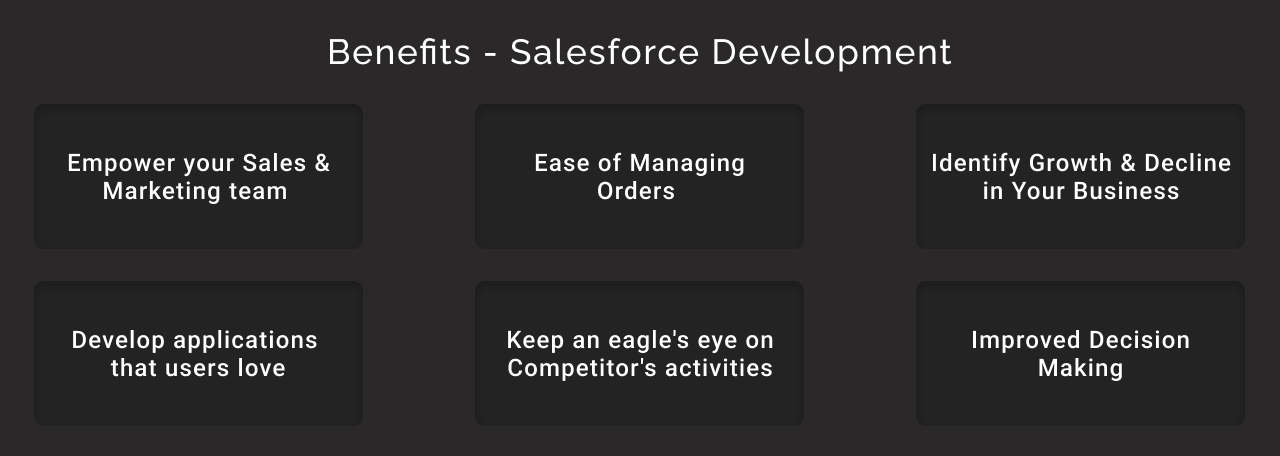Salesforce Development Lifecycle: Process, Models, And Challenges
Table of Contents
Salesforce is growing swiftly and becoming popular among businesses in various industries. It offers all the required features a business can use to accelerate growth. Lead management, running effective marketing campaigns, managing & storing customer data, and improving communication are examples of what Salesforce can do.
Sounds fascinating? It is. But building and deploying a Salesforce application is no small feat. It requires careful planning, collaboration, and testing to ensure the application meets the business’s and its customers’ needs.
Enter the Salesforce Development, a comprehensive framework for developing, testing, and deploying Salesforce applications. It encompasses a range of activities, including requirements gathering, design, coding, testing, and deployment. But with so many moving parts, it’s no surprise that there are plenty of challenges to overcome along the way.
This blog post will provide a comprehensive examination of the Salesforce Development Lifecycle. You will discover various models and methodologies and the significant challenges that businesses and developers may encounter during the process.
Whether you are an experienced Salesforce professional or a novice, you can expect to gain valuable insights and tips that will assist you in achieving success in your next Salesforce project. Without further ado, let’s get started.
What Is Salesforce Development?
Salesforce development refers to building, customizing, integrating, and extending the functionality of the Salesforce platform to create a cloud-based Salesforce application catering to different business-specific issues.
Salesforce allows the usage of various programming languages and integrated development environments for creating applications such as Apex, Visualforce, and Salesforce Lightning Platform.
Businesses can build or develop custom applications, user interfaces, business logic, and integrations with third-party apps or systems using these programming languages.
With Multi-tenant architecture and user-friendly interfaces, Salesforce empowers businesses to introduce ease of use and flexibility in ongoing business practices. Therefore, following the Salesforce development lifecycle thoroughly is crucial to get the best Salesforce application as output.
Salesforce Development Lifecycle
Salesforce Development Lifecycle (SDLC) is a structured framework that outlines the essential stages involved in development. It provides a systematic approach that encompasses all the necessary elements from the beginning to the end of creating applications and functionalities on the platform.
It comprises six stages which are discussed below:


Stage 1: Prepare The Development Plan
Before you head to the development part, the first step is to draft a plan inclusive of requirements and perform an analysis. You can keep your Product Manager alongside for gathering specifications and which things are creating hindrances. Once your project idea is ready, discuss it meticulously with your team or development Partner and ensure all essentials tools, environments, and access are ready.
At this stage, you may also need to decide between customization and configuration based on your platform needs. We’ve covered this decision in detail in our blog on Customization vs. Configuration in Salesforce.
Stage 2: Get Moving With The Development
Kick-start with the development part considering the pre-determined specifications. Lightning Platform has the right combination of tools like Custom Object Wizard, Flow Builder, and other complementary UI tools. Programmatic tools such as Source Code Editor, Developer Console, and Visual Studio Code are available. Check that the entire development part will be conducted in an environment with a copy of production org metadata without production data.
Stage 3: Test
Keep your work on the clock and assess it at every step to ensure everything works right before you connect it with all the user systems. While testing, use the same environment you used for development but keep the integration and development environment distinct.
Stage 4: Build Release
At this stage of development, it’s important to bring all the pieces of the puzzle together and consolidate everything you’ve created and modified. Take the time to combine everything into a single frame when complete with the development process. A single-release artifact comprising customizations of logical bundles you have produced for deployment needs to aggregate. Direct all your efforts to what you have on your platter for release.
Step 5: Test Release
Ensure the readiness of your deployment by testing it in a secure staging environment that closely replicates production conditions, using representative production data. Ensure the test environment is connected to all external systems to simulate production integrations accurately. Perform complete regression and performance testing, and gather feedback from a select group of experienced users through user-acceptance testing.
Step 6: Release
Once the testing is complete and your team is assured of the quality, start deployment of the customization to your production. Ensure your employees are well-acquainted with the entire setup and changes. You can set up a consolidated training environment with real-time data if your release significantly impacts the users.
Managing this can be quite a challenge, but having a Salesforce development partner by your side can make the process more streamlined and convenient. Partners bring years of experience and expertise, which can help mitigate various risks associated with managing releases. Additionally, they provide the necessary support needed after the release.
Salesforce Development Models
The term “Salesforce development models” describes various methodologies utilized in designing, constructing, testing, and deploying applications on the Salesforce platform.
Salesforce has two categories of Development models that support the source origin:


Org Development Model
Org Development model offers different tools that provide users with greater flexibility, scalability, a unique method for deployment, and new ways to manage track, and deploy changes in sandboxes and later in your production org.
A source control repository is what the Org Development model uses to store all the changes and files related to projects. This repository neutralizes the gap in keeping environments in alignment. Once changes are externalized for every release, your team will get to know that the Source Repository shows what they are delivering, simultaneously keeping it the same while making alterations to the environment. With this consistency, a developer can move at a proper speed in development, testing, and release settings.
Now, let’s know more about the Release artifact, which consists set of metadata changes that one needs to make in the production org. The development team can take the help of change tracking mechanisms for trailing the changes done in various components and compare it with the changes done through the setup UI in the org. This enables identifying the contribution of all the people involved in the process.
Furthermore, Salesforce Extensions for VS code are the best choice to retrieve metadata from the development environments. With the help of Salesforce Extensions, you can store the changes in source control and create an automated process to test and deploy to production. This process also dilutes another pain point, i.e., repetitive creation and deployment change sets due to errors and variations between environments.
Package Development Model
For organizations that usually have large-scale Salesforce development projects with multiple complexities, managing changes done by every active team member is pretty stimulating. Then the organization must consider getting a development model that takes care of all the changes happening and rationalizes the development lifecycle from start to end.
Package Development Model is the one that businesses should get in this situation as it brings along a lot of benefits:
- Enhance collaboration and team management
- Supports change management
- Streamlines automated testing and provides continuous integration.
- Make the release cycle more effective and lively. Modular development process coupled with the specification of dependencies in various packages.
- Setup features that improve Version Control System (VCS) synchronization via change tracking.
- Better visibility and conciseness in the change management of production org.
In addition to these models, another approach that’s becoming increasingly popular is the agile methodology for Salesforce development. It is all about flexibility and quick iteration, which makes it perfect for businesses that need to adapt to changing requirements and customer demands fast.
Benefits of Salesforce Development for Your Business
When Salesforce development is completed correctly, it provides you with many benefits. Some of them are listed below:


1. Empower Your Sales and Marketing Team
Salesforce developments helps organizations create smart calendars, reports, dashboards, analytics, etc., to keep sales and marketing teams updated with real-time performance. With this, teams will always be ready to identify and convert opportunities, get more deals finalized, and increase revenues. Plus, with guided selling, users will know when and what move they should make to close the deal.
2. Ease of Managing Orders
By providing a centralized processing, automation, and tracking platform, Salesforce can help businesses manage orders more efficiently and effectively. The platform’s customizable workflows and integration capabilities allow seamless order management processes for business-specific unique needs. This improves efficiency and accuracy while reducing errors.
3. Identify Growth and Decline in Your Business
From potential opportunities to areas of improvement, Salesforce takes care of every aspect in between and ensures the growth of your business. Even in strategy formulation, teams can refer to business performance in the market and the steps they can follow to go to the top. In addition, reports and Dashboards let teams predict if there is an approaching time when business might face a decline.
4. Develop Applications that Users Love.
Salesforce offers a variety of customization options that help teams in creating an application a customer will love to use. With its extensive functionalities like multi-tenant cloud-based architecture, process automation, data analytics, performance management, UI & UX manager, and customer support, designing an application defining business success has become easier than ever. For a comprehensive guide on building such application, including practical examples, refer to our detailed guide on Salesforce App Development.
5. Keep an Eagle’s Eye on Competitor’s Activities
Salesforce CRM analytics provides businesses with tools for monitoring competitors and gaining insights into their sales, marketing, and customer engagement strategies. By analyzing data on competitors’ performance, businesses can benchmark their performance, identify areas for improvement, and inform product development and pricing strategies, giving them a competitive advantage.
6. Improved Decision-Making
Salesforce entitles your teams to envision where you are at the present moment in the market and where you want to be in the future. When data is stored, managed, and updated on time, your team will have more room to study the current market trends and act accordingly. Sounds promising? If you’re considering how Salesforce development could benefit your business, you might want to check out our detailed blog on signs your business needs Salesforce development. It’s a great read to help you decide if it’s the right move for your business.
Challenges Faced in Salesforce Development
Even though you have clarity in your mind on how your Salesforce development process should go, there are still some setbacks you might encounter.
Here are some potential challenges that can restrict you from getting benefit from Salesforce development effectively:


1. Lack of Expertise
Salesforce Development, for sure, calls for the presence of experienced developers having expertise in different horizontal and verticals of Salesforce. Having people of such caliber on your team is not always mandatory. You can invest in getting Salesforce, but to expect a return from that investment, you can hire Salesforce developers or avail services from a certified Salesforce development partner.
2. Difficulty in Customization
Every business has its personalized operations and customizations that they want to be in their CRM. Salesforce offers many customization options to make the development process more manageable. However, it will take time to understand which tools can fulfill your current requirements. Doing this alone is going to consume a lot of time.
For optimal utilization of Salesforce, having someone who possesses these two qualities is crucial. One is a deep understanding of the business needs and the technical expertise to tailor Salesforce to meet those needs.
3. Inadequacy of Support From Salesforce
Although Salesforce offers complimentary support to its clients, the average turnaround time for a response is two days. This can hinder completing tasks within a specific time frame. If you encounter obstacles during development. You can refer to resources available on Trailhead Video Library, User Community, and Guided Journeys.
If additional help is needed, you can connect with the Salesforce Support team. They will guide you and resolve your problems directly. Or you can get assistance from the hired Salesforce team. A Salesforce team comprises Salesforce Developers, Business Analysts, Quality Assurance Analysts, Consultants, or Architects.
4. Lack of Clarity on User Permissions
Without enough knowledge, you might give administrative permissions to those users who don’t need it. For example, Salesforce has assigned different permissions to different roles and profiles to maintain the security and confidentiality of information.
You are aggregating all the essential information by getting Salesforce as your Customer Relationship management software. This information includes data on business operations, customers, revenue, and opportunities.
User management in Salesforce requires expertise, including customization of user permissions and proper creation of profiles and hierarchy. Unfortunately, companies overlook the significance and intricacy of this aspect and its impact on data integrity.


The Final Words
Salesforce development can significantly enhance your business growth and success. However, partnering with a skilled development partner is essential to navigate the entire development lifecycle, ensuring your applications are bug-free, user-friendly, and aligned with all aspects of your business. With years of experience in the Salesforce ecosystem, our team through our exceptional Salesforce development services has successfully delivered a diverse range of projects across various industries. Thus, if you’re looking to optimize your existing processes or have a concept that needs to be transformed into a functional solution, our experts are eager to discuss your ideas. Schedule a call with us today!
Don’t Worry, We Got You Covered!
Get The Expert curated eGuide straight to your inbox and get going with the Salesforce Excellence.
AUTHOR
Vishwajeet Srivastava
Salesforce Data Cloud, AI Products, ServiceNow, Product Engineering
Co-founder and CTO at Cyntexa also known as “VJ”. With 10+ years of experience and 22+ Salesforce certifications, he’s a seasoned expert in Salesforce Data Cloud & AI Products, Product Engineering, AWS, Google Cloud Platform, ServiceNow, and Managed Services. Known for blending strategic thinking with hands-on expertise, VJ is passionate about building scalable solutions that drive innovation, operational efficiency, and enterprise-wide transformation.


Cyntexa.
Join Our Newsletter. Get Your Daily Dose Of Search Know-How
Frequently Asked Questions
Salesforce Development refers to developing an application onto the CRM platform catering to business-specific needs. The process commences when a business knows what personalization and customization they want in their CRM. It ends with the final application delivery and making it available for the customers.
The lifecycle of Salesforce development typically includes planning, design, development, testing, deployment, and maintenance phases.
The Salesforce development process involves Analyzing requirements, Designing a solution, Building and testing a solution, and Deploying it to the end users.
There are two models used in Salesforce Development:
- Org Development model comprises different resourceful tools, varying deployment methods, more scope to scalability, and features to track changes in the sandboxes and later in production org.
- Another is the Package Development model which is ideal for businesses with large-scale operations that need a unified platform to manage everything from sales and service activities to the analysis of business processes.





